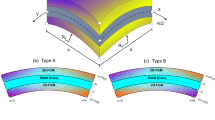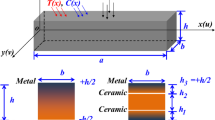Abstract
Beam-in-beam large sliding contact exists in simulations of drillstring-riser systems, offshore pipe-in-pipe systems, medical catheter-guidewire-stent systems, among others. Large sliding between the pipes may lead to discontinuity of contact force and non-sparsity of system Jacobian in numeric simulations, which then may result in non-physical disturbances and low efficiency. To overcome this phenomenon, a consistent-contact-force algorithm and a highly efficient implicit-integration scheme are proposed in this paper. Geometric treatments are applied in gap and overlap areas to obtain continuous contact force, in addition to contact-history-based fast detection. The contact force Jacobian is ignored as the flexible multibody system is solved with an inexact Newton iteration and an empirical formula is used to estimate the convergence conditions. Four numeric examples are computed to verify the presented method, including a buckling benchmark and a riser-recoil industrial application. The numeric results show that the proposed method is accurate and highly efficient.



















Similar content being viewed by others
References
Bueno RCS, Morooka CK (1994) Analysis method for contact forces between drillstring-well-riser
Fontaine E, Heurtier JM, Durville D, Toumit S, Prat C (2002) Modeling of riser contact-friction problems. In: Offshore technology conference
Han CJ, Yan T, Tong YS (2016) The analysis on coupling vibration of drill string and marine riser in deep-water drilling. Int J Multiphys 7(1):53–60
Liao M, Zhou Y, Su Y, Lian Z, Jiang H (2018) Dynamic analysis and multi-objective optimization of an offshore drilling tube system with pipe-in-pipe structure. Appl Ocean Res 75:85–99
Hao LP, Dung TQ (2003) Applying the contact element for simulation of interaction between drillstring and holewall. Vietnam J Mech 25(2):97–112
Wang NY, Cheng Z, Lu YJ, Zhou J, He B, Ren G (2015) A multibody dynamics model of contact between the drillstring and the wellbore and the rock penetration process. Adv Mech Eng 7(5):1687814015582117
Callejo A, Arbatani S, Koevecses J, Kalantari M, Marchand NR (2017) Drill bit contact dynamics including side cutting: simulation and validation. J Energy Resour Technol 139(2):022910
Liu J, Zhong X, Cheng Z, Feng X, Ren G (2018) Buckling of a slender rod confined in a circular tube: theory, simulation, and experiment. Int J Mech Sci 140:288–305
Liu JP, Cheng ZB, Ren GX (2018) An arbitrary Lagrangian-Eulerian formulation of a geometrically exact Timoshenko beam running through a tube. Acta Mech 229:3161–3188
Chen KD, Chen JQ, Hong DF, Zhong XY, Ren GX (2019) Efficient and high-fidelity steering ability prediction of a slender drilling assembly. Acta Mech 230:3963–3988
Lenoir J, Cotin S, Duriez C, Neumann P (2006) Physics-based models for catheter, guidewire and stent simulation. Stud Health Technol Inform 119:305–310
Lenoir J, Cotin S, Duriez C, Neumann P (2006) Interactive physically-based simulation of catheter and guidewire. Comput Graph 30:416–422
Duriez C, Cotin S, Lenoir J, Neumann P, Dawson S (2006) New approaches to catheter navigation for interventional radiology simulation. Comput Aided Surg Off J Int Soc Comput Aided Surg 11(Pt 2):300–8
Magliulo M, Lengiewicz J, Zilian A, Beex LA (2020) Beam-inside-beam contact: mechanical simulations of slender medical instruments inside the human body. Comput Methods Progr Biomed 196:105527
Magliulo M, Lengiewicz J, Zilian A, Beex LAA (2020) Frictional interactions for non-localised beam-to-beam and beam-inside-beam contact. Int J Numer Methods Eng 196:105527
Magliulo M, Lengiewicz J, Zilian A, Beex LAA (2020) Non-localised contact between beams with circular and elliptical cross-sections. Comput Mech 65, 1247–1266
Wriggers P, Krstulovic-Opara L, Korelc J (2001) Smooth C1-interpolations for two-dimensional frictional contact problems. Int J Numer Methods Eng 51(12):1469–1495
Hallquist JO, Goudreau GL, Benson DJ (1984) Sliding interfaces with contact-impact in large-scale Lagrangian computations. Comput Methods Appl Mech Eng 51(1–3):107–137
Curnier A, Alart P (1988) A generalized newton method for contact problems with friction. Journal de Mecanique Theorique et Appliquee 7:67–82
Peric D, Owen DRJ (1992) Computational model for 3d contact problems with friction based on the penalty method. Int J Numer Methods Eng 35(6):1289–1309
Lorenzis LD, Temizer I, Wriggers P, Zavarise G (2011) A large deformation frictional contact formulation using nurbs-based isogeometric analysis. Int J Numer Methods Eng 87:1278–1300
Batailly A, Magnain B, Chevaugeon N (2013) A comparative study between two smoothing strategies for the simulation of contact with large sliding. Comput Mech 51(5):581–601
Duong TX, Sauer RA (2018) A concise frictional contact formulation based on surface potentials and isogeometric discretization. Comput Mech 64:951–970
Chen H, Lei Z, Zang M (2014) LC-grid: a linear global contact search algorithm for finite element analysis. Comput Mech 54(5):1285–1301
Oishi A, Yagawa G (2020) A surface-to-surface contact search method enhanced by deep learning. Comput Mech 65(2):1–23
Wriggers P (2002) Computational contact mechanics. Wiley, Hoboken
Zhang H, Guo J, Liu JP, Ren GX (2020) An efficient multibody dynamic model of arresting cable systems based on ale formulation. Mech Mach Theory 151:103892
Bridson R, Fedkiw R, Anderson J (2002) Robust treatment of collisions, contact and friction for cloth animation. ACM Trans Graph 21(3):594–603
Oliver J, Huespe AE, Cante JC (2008) An implicit/explicit integration scheme to increase computability of non-linear material and contact/friction problems. Comput Methods Appl Mech Eng 197(21–24):1865–1889
Wu JJ (2006) Numerical analyses on elliptical adhesive contact. J Phys D Appl Phys 39(9):1899–1907
Bjorkman G (2010) The solution of large displacement frictionless contact problems using a sequence of linear complementarity problems. Int J Numer Methods Eng 31(8):1553–1566
Yang C, Du J, Cheng Z, Wu Y, Li C (2020) Flexibility investigation of a marine riser system based on an accurate and efficient modelling and flexible multibody dynamics. Ocean Eng 207:107407
Heidelberger B, Teschner M, Keiser R, Müller M, Gross MH (2004) Consistent penetration depth estimation for deformable collision response. In: VMV, vol 4. Citeseer, pp 339–346
Schenk O, Grtner K (2002) Solving unsymmetric sparse systems of linear equations with pardiso. In: International conference on computational science
Schenk O, Gartner K (2010) Pardiso. Future Generation Computer Systems
Shabana AA (1978) Dynamics of multibody systems. Cambridge University Press, Cambridge
Wu J, Juvkam-Wold HC, Lu R (1993) Helical buckling of pipes in extended reach and horizontal wells—part 1: Preventing helical buckling. J Energy Resour Technol 115(3):190–195
Tikhonov VS, Safronov AI, Gelfgat MY (2006) Method of dynamic analysis for rod-in-hole buckling. In: ASME 8th Biennial conference on engineering systems design and analysis
Pogorelov D, Mikheev G, Lysikov N, Ring L, Abedrabbo N (2012) A multibody system approach to drill string dynamics modeling. In: ASME Biennial conference on engineering systems design and analysis
Liu J, Zhong X, Cheng Z, Feng X, Ren G (2018) Post-buckling analysis of a rod confined in a cylindrical tube. J Appl Mech 85(7):071001
Acknowledgements
This research was supported by NSFC (11772170), the Project on Electric Driver Seat Technology for Large Passenger Aircraft (MJ-2018-S-44), the National Basic Research Program of China (2015CB251203) and the National Key R&D Program of China (2017YFC0307100), all of whom are gratefully acknowledged by the authors.
Author information
Authors and Affiliations
Corresponding author
Ethics declarations
Conflicts of interest
The authors declare that they have no conflicts of interest.
Additional information
Publisher's Note
Springer Nature remains neutral with regard to jurisdictional claims in published maps and institutional affiliations.
Appendix A: Magnitude analysis of \(s_{c}\), \(s_{m}\) and \(s_{k}\) in the empirical estimation
Appendix A: Magnitude analysis of \(s_{c}\), \(s_{m}\) and \(s_{k}\) in the empirical estimation
Begin with Eq. 49:
where the magnitude of \(\beta _{0}\) and \(\gamma _{0}\) are \(O\left( h^{-1}\right) \) and \(O\left( h^{-2}\right) \), respectively, as presented in Yang et al. [32].
When \(\beta _{0}=A_{\beta }h^{-1}\) and \(\gamma _{0}=A_{\gamma }h^{-2}\)—where \(A_{\beta }=1.5,1.83,2.08\text { and }2.28\); and \(A_{\gamma }=1,2,2.92\text { and }3.75\), respectively, for BDF order \(p=2,3,4,5\) in the fixed-step-size integration—we have:
If all damping is ignored (i.e., \(a_{c}=a_{k}=a_{m}=0\)), we have:
If the step size takes the same magnitude as the system damping, i.e., \(h=a_{m}=a_{c}=a_{k}=o\left( 1\right) \), we have:
Rights and permissions
About this article
Cite this article
Yang, C., Du, J., Cheng, Z. et al. A highly efficient beam-in-beam large sliding contact method for flexible multibody dynamics. Comput Mech 67, 1155–1175 (2021). https://doi.org/10.1007/s00466-021-01984-9
Received:
Accepted:
Published:
Issue Date:
DOI: https://doi.org/10.1007/s00466-021-01984-9




